สภาวะที่เหมาะสมต่อการยับยั้งการเจริญเติบโตของจุลินทรีย์ในกุ้งขาวแวนนาไมโดยน้ำกระตุ้นด้วยพลาสมา
Main Article Content
บทคัดย่อ
งานวิจัยนี้มีวัตถุประสงค์เพื่อศึกษาสภาวะที่เหมาะสมต่อการยับยั้งการเจริญเติบโตของจุลินทรีย์ในกุ้งขาวแวนนาไมโดยน้ำกระตุ้นด้วยพลาสมา (Plasma Activated Water; PAW) ที่ช่วยสังเคราะห์อนุมูลไฮดรอกซิล (OH•) ในรูปของไฮโดรเจนเปอร์ออกไซด์ให้มีประมาณความเข้มข้นสูงขึ้น ปัจจัยการศึกษาหาปริมาณความเข้มข้นของไฮโดรเจนเปอร์ออกไซด์ ได้แก่ อัตราการไหลของก๊าซผสมอาร์กอนและออกซิเจน (อาร์กอน 98 เปอร์เซ็นต์ และออกซิเจน 2 เปอร์เซ็นต์) และระยะเวลาดิสชาร์จ โดยนำวิธีออกแบบการทดลองแบบแฟคทอเรียลเต็มจำนวน (22) ที่จุดกึ่งกลาง 5 จุด เพื่อนำไปกำหนดเงื่อนไขของปัจจัย และการทดลองยับยั้งการเจริญเติบโตของจุลินทรีย์ในกุ้งขาวแวนนาไมบนอาหารเลี้ยงเชื้อ ผลการทดลองพบว่า สภาวะที่เหมาะสมที่สุด คือ อัตราการไหลของก๊าซผสมอาร์กอนและออกซิเจน 25 ลิตรต่อนาที และระยะเวลาดิสชาร์จ 120 นาที ทำให้มีปริมาณความเข้มข้นของไฮโดรเจนเปอร์ออกไซด์ 12.43 มิลลิกรัมต่อลิตร ที่ระยะเวลาการทดลอง 10 นาที น้ำกระตุ้นด้วยพลาสมาสามารถลดจุลินทรีย์ทั้งหมดในกุ้งขาวแวนนาไมจาก 5.98 log CFU/กรัม เหลือเพียง 3.49 log CFU/กรัม หรือประมาณ 41.63 เปอร์เซ็นต์
Article Details

อนุญาตภายใต้เงื่อนไข Creative Commons Attribution-NonCommercial-NoDerivatives 4.0 International License.
บทความที่ลงตีพิมพ์เป็นข้อคิดเห็นของผู้เขียนเท่านั้น
ผู้เขียนจะต้องเป็นผู้รับผิดชอบต่อผลทางกฎหมายใดๆ ที่อาจเกิดขึ้นจากบทความนั้น
เอกสารอ้างอิง
R. Kongkum. “Production of bacteriocin by Enterococcus faecalis ts9s17 and application to inhibit Listeria monocytogenes in peeled cooked shrimp,” Master’s thesis, Department of Biotechnology Sciences, Graduate School, Prince of Songkla University, Songkla, Thailand, 2015.
H. Hosseini, A. M. Cheraghali, R. Yalfani, and V. Razavilar, “Incidence of Vibrio spp. in shrimp caught off the south coast of Iran,” Food Control, vol. 15, No. 3, pp. 187–190, 2004.
S. Janthima, C. Sawangrat, D. Boonyawan, S. Lumyong, J. Kumla, and N. Suwannarach, “Appropriate parameters of plasma activated water for growth inhibition of E. coli by Box- Behnken design,” Engineering Journal Chiang Mai University, vol. 26, pp. 179–189, 2019 (in Thai).
L. A. Keskinen, A. Burke, and B. A. Annous, “Efficacy of chlorine, acidic electrolyzed water and aqueous chlorine dioxide solutions to decontaminate Escherichia coli O157:H7 from lettuce leaves, Int J Food Microbiol, vol. 132, pp 134–140, 2009.
M. Sireno, E. T. Mársico, M. da Silva Ferreira, M. L. G. Monteiro, H. de Carvalho Vital, C. A. C. Júnior, and S. B. Mano. “Propriedades ísico-químicas, sensoriais e bacteriológicas de camarões (Litopenaeus brasiliensis) irradiados e armazenados sobrefrigeração,” Rev. Bras. Cienc vet., vol. 17, pp. 91–95, 2010.
J. Shen, Y. Tian, Y. Li, R. Ma, Q. Zhang, J. Zhang, and J. Fang, “Bactericidal effects against S. aureus and physicochemical properties of plasma activated water stored at different temperatures,” Sci Rep-UK, vol. 6, 2016, Art. no. 28505.
R. Thirumdas, A. Kothakota, U. Annapure, K. Siliveru, R. Blundell, R. Gatt, and V. P. Valdramidis, “Plasma activated water (PAW): Chemistry, physico-chemical properties, applications in food and agriculture,” Trends Food Sci Technol, vol. 77, pp. 21–31, 2018.
Q. Zhang, Y. Liang, H. Feng, R. Ma, Y. Tian, J. Zhang, and J. A. Fang, “Study of oxidative stress induced by non-thermal plasma-activated water for bacterial damage,” Appl Phys Lett, vol. 102, 2013, Art. no. 203701.
F. Girard, M. Peret, N. Dumont, V. Badets, S. Blanc, K. Gazeli, C. Noël, and T. Belmonte, “Correlations between gaseous and liquid phase chemistries induced by cold atmospheric plasmas in a physiological buffer,” Phys Chem Chem Phys, vol. 20, pp. 9198– 9210, 2018.
Z. Machala, B. Tarabová, D. Sersenová, M. Janda, and K. Hensel, “Chemical and antibacterial effects of plasma activated water: Correlation with gaseous and aqueous reactive oxygen and nitrogen species, plasma sources and air flow conditions,” J Phys D Appl Phys, vol. 52, 2018, Art. no. 034002.
C. Smet, M. Govaert, A .Kyrylenko, M. Easdani, J. L. Walsh, and J. F. Van Impe, “Inactivation of single strains of Listeria monocytogenes and Salmonella Typhimurium planktonic cells and biofilms with plasma activated liquids,” Front Microbiol., vol. 10, 2019, Art. no. 1539.
A. Zaribafan, K. Haghbeen, M. Fazli, and A. Akhondali, “Spectrophotometric method for hydrogen peroxide determination through oxidation of organic dyes,” Environmental Studies of Persian Gulf, vol. 1, no. 15, pp. 93–101, 2014.
C. Kang, D. Zhao, W. Wang, L. Niu, and Y. Bai, “Inactivation of Pseudomonas deceptionensis CM2 on chicken breasts using plasma-activated water,” Food Science and Technology, vol. 56, pp. 4938–4945, July 2019.
K. Sunil and B. Narayana, “Spectrophotometric determination of hydrogen peroxide in water and cream sample,” Bulletin of Environmental Contamination and Toxicology, vol. 81, pp. 422–426, 2008.
H. S. Kim, D. H. Lee, A. Fridman, and Y. I. Cho, “Residual effects and energy cost of gliding arc discharge treatment on the inactivation of escherichia coli in water,” Heat and Mass Transfer, vol. 77, pp. 1075–1083, 2014.
Office of the Food and Drug Administration. (2016). Manual for Compliance with the Notification of the Ministry of Public Health (No. 364) 2013 on food standards for microbes causing disease. Office of the Food and Drug Administration. Bangkok, Thailand [Online]. Available: http://e-library.dmsc.moph.go.th/ ebooks/files/micro-ISBN60.pdf
P. Lules, E. Dolezalona, I. Sisraova, and M. Clupek, “Aqueous-phase chemical and bactericidal effects from an air discharge plasma in contact with water: Evidence for the formation of peroxynitrite though a pseudosecond- order post—discharge reaction of H2O2 and HNO2,” Plasma Sources Science and Technology, vol. 23, no. 1, 2014, Art. no. 015019.
K. Marouf-Khelifa, F. Abdelmalek, A. Khelifa, M. Belhadj, A. Addou, and J. L. Brisset, “ Redution of nitrite by sulfamic acid and sodium azide from aqueous solutions treated by gliding arc discharge,” Separation and Purification Technology, vol. 50, no. 3, pp. 373–379, 2006.
J. Shen, Y. Tian, Y. Li, R. Ma, Q. Zhang, and J. Fang, “Bactericadal effects against s. aureus and physicochemical properties of plasma activated water stored at different temperatures,” Scientific Reports, vol. 6, 2016, Art. no. 28505.
P. Sun, H. Wu, N. Bai, H. Zhou, R. Wang, H. Feng, and J. Fang, “Inactivation of Bacillus subtilis spores in water by a direct-current, cold atmospheric-pressure air plasma microjet,” Plasma Processes and Polymer, vol. 9, no. 2, pp. 157–164, 2012.
N. N. Misra, “Quality of cold plasma treated plant foods,” in Cold Plasma in Food and Agriculture. Academic Press, 2016, pp. 253–271.

